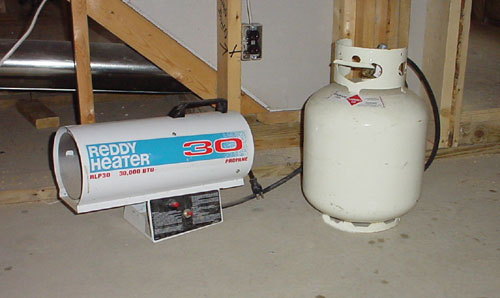When your workers take breaks, it often is difficult for them to get warm in unheated and uninsulated buildings being constructed during cold weather. Using temporary salamander-type heaters, as well as burning scrap construction debris in burn barrels, can help.

To get warm, workers often use temporary heaters, such as the propane heater shown here.
But when improperly used, heaters and burn-barrel fires can cause property damage and injure workers and others at job sites.
Following are some tips to help your workers stay warm—safely.
Heaters
Instruct your workers to set a salamander-type heater level on a solid surface and away from flammable or combustible materials. Workers should not let a heater operate unattended nor should they use it to warm equipment or materials. In addition, no one should smoke around propane or kerosene.
Salamander-type heaters are not designed to be used in low-ventilated indoor spaces—they deplete oxygen from the air and emit fumes and carbon monoxide. If roofing workers complain about burning eyes or headaches, turn off the heater and immediately take them into fresh air.
If a salamander-type heater runs on propane, have roofing workers make sure all fittings are tight and in good condition. They also should check fittings for leaks with soapy water.
Because propane is heavier than air, leaking propane can collect in low areas or basements. Propane leaks become particularly dangerous when workers who use power tools are not aware of the leaks—most power tools spark.
To use a propane heater, your workers first must start the fan, turn on the propane bottle valve and then press the sparking igniter.
If a propane tank frosts, the propane bottle is too small. Workers should not defrost the bottle with the heater. Instead, they should turn off the heater and use a larger bottle. Workers should turn off the heater by closing the valve on the propane bottle and then shutting off the heater fan after the flame has been extinguished. The valve should be closed when the heater is not being used.
If your workers use a kerosene salamander-type heater, ensure the kerosene is stored in a blue, metal safety container, which must have a label identifying it as kerosene. Kerosene must be stored a safe distance from the heater.
Kerosene heaters tend to give off more fumes than propane heaters and can make your workers dizzy and nauseous. Therefore, workers always should use fresh kerosene and keep a heater clean and well-maintained. Workers also must shut off the heater and allow it to cool before refueling.
Burning debris
Another method workers frequently use to warm themselves is burning scrap construction debris in a 55-gallon (209-L) drum, or burn barrel. This helps remove debris from job sites, as well as warm cold hands.
When using a burn barrel, workers should ensure it is in good condition. Remind workers to never burn plastic, rubber or materials that cause noxious smoke or fumes. They also never should use a burn barrel indoors nor burn debris in an open fire on the ground. This allows burning embers to blow around and is banned in many municipalities.
Workers must ensure a burn-barrel fire completely is extinguished and cold before leaving a job site.
Temporary heaters can make working more comfortable during cold weather. Using these common-sense tips will help your workers stay safe and avoid fires on your projects.
Bill Steinmetz is NRCA's risk-management consultant.
